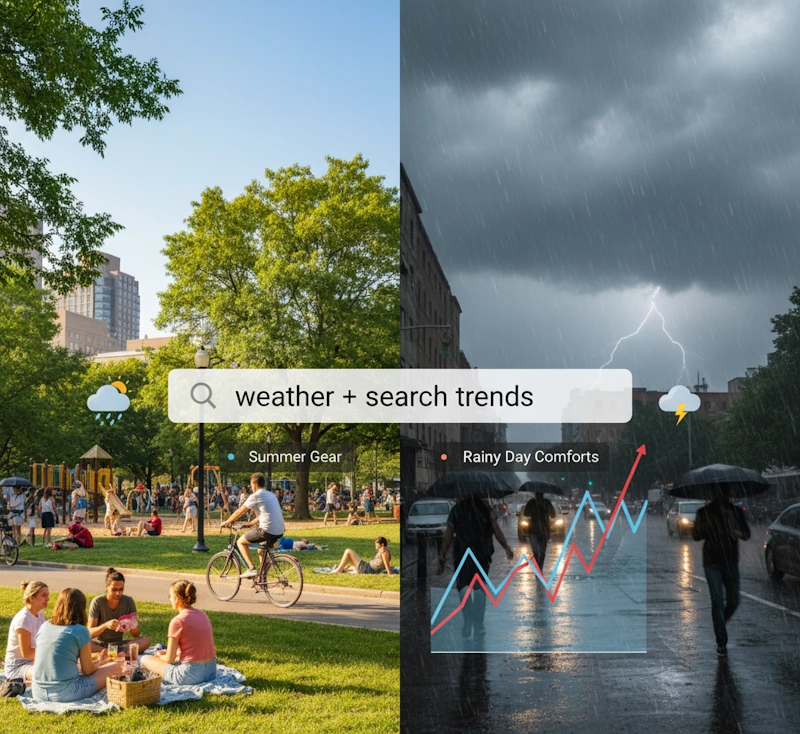Search behavior shifts with the seasons. When temperatures change, so do the things people care about, search for, and buy. A gardener types “early spring planting tips” weeks before the first bloom. A homeowner looks for “furnace tune-up specials” the moment cold weather settles in. Those spikes follow the weather.
That rhythm is perfect for planning. Pay attention to how local conditions shape interest, and you can time blog posts, offers, and ads for the moment people are already looking.
Seasonal SEO works best when your timing matches what’s happening outside. Align your calendar with the forecast, and your content lands right when it’s needed.
Understanding Seasonal SEO (and Why Timing Is Everything)
Seasonal SEO means lining up your search and content strategy with the cycles that shape demand. Weather, holidays, and lifestyle shifts all influence what people search for. When those moments arrive, attention narrows, and the businesses that prepare early tend to capture it first.
Use weather data as an early signal. Watch for the first uptick and publish before the peak. Searches for “air conditioner maintenance” rise well ahead of the first heat wave. Interest in “snow removal services” jumps weeks before the first snowfall. The cycle repeats year after year, which turns timing into a decision rather than a guess.
Looking at local weather trends helps you spot those windows. Tools like the Visual Crossing weather engine let you review past seasons and compare conditions with known busy periods. That perspective guides when to publish new posts, refresh proven ones, or promote services that fit the season’s mood.
Make an Appointment for Free Consultation
Using Weather Data to Plan Smarter Content
Every industry has predictable moments when attention rises. Pair weather data with search trends, and you can plan content that feels right on time.
Start with how conditions change decisions. A landscaping company can publish lawn care guides as soil temperatures begin to warm. A coffee shop can feature cold brew recipes the week a heat wave rolls in. A boutique can promote rain gear before the first storm of the season. These choices come from data, not guesswork, and they match intent with what people feel outside.
Check Google Trends to see how searches move with the weather. Map local temperature shifts against keyword spikes to spot when interest starts climbing. Once the pattern is clear, set publishing dates, refresh seasonal evergreen posts, and queue emails to land just before demand crests.
Applying Weather Insights to Promotions and Local SEO
Weather influences both search intent and buying urgency. Teams that respond to those changes keep their marketing in step with local demand.
A roofing company can highlight storm repair services before heavy rain appears in the forecast. A café can push warm pastries as cooler mornings return. Simple updates matter too. Add seasonal keywords to your homepage, write timely blog intros, and adjust copy on your Google Business Profile to reflect what customers are seeking right now.
Treat your promotions as flexible. If spring arrives early, move your calendar forward. If a cold front lingers, extend winter offers. Working with the forecast gives you a practical edge in timing and helps each campaign feel one step ahead.
Tools and Tips for Tracking Weather and Search Trends
You don’t need complex analytics to link weather patterns with search behavior. A small set of tools can show when interest rises and how local conditions play a role.
Start with a reliable source for local weather data. Look for a platform that provides historical temperatures, rainfall, and seasonal patterns. Pair those signals with Google Trends or your keyword planner to see when search interest typically climbs.
Keep a straightforward content calendar that ties those cues to your marketing plans. Note the first warm week of spring, the earliest snow, and the months when storms usually roll through. Over time, the relationship between timing and response becomes clear, especially once you understand how SEO impacts website traffic and use that insight to schedule posts before demand crests.
Turning Forecasts into Fresh Content
Seasonal SEO rewards teams that notice small shifts and respond with the right message at the right time. When your content reflects what people are already thinking about, you meet them at the moment of interest.
Planning with weather data doesn’t have to be complicated. A quick look at local patterns, combined with a working sense of how search behavior changes through the year, can turn your calendar into a living reflection of your community. That awareness keeps your marketing fresh, your timing natural, and your audience engaged season after season.




